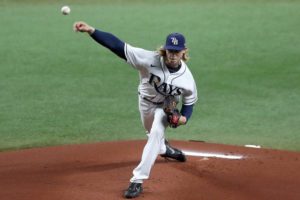2022 Rookie Pitchers with a BABS lens
by Curt Brooks
What Mike Trout’s 2012 rookie season is to hitters, Jose Fernandez’s 2013 rookie season is to pitchers. However, it is critical to know that pitchers typically take longer to develop than hitters and are harder to predict. For instance, one needs to look no further than Jacob deGrom, who took an additional four years from his 2014 ROY season to mature to his current Cy Young level of greatness. The bottom line is that one must be patient with young arms.
(MLE ratings from BABS Minor League Ratings Page)
2021 call-ups who still qualify as rookies
Unless noted otherwise, all pitchers in this category are projected for at least some playing time.
Shane Baz (ER,K+), pictured, comes out on top with no skill liabilities, and these ratings are fully supported by his MLEs (E+,K+), placing him in potentially elite territory. Edward Cabrera (e,KK) has virtually identical MLEs and no skill liability; he could also be a valuable contributor.
Others making their debut last year include Aaron Ashby (ER,K+) with an MLE of (KK). Reid Detmers (KK) had strong MLEs (ER,K+) but carries a minor injury tag.
Nate Pearson (KK) demonstrated MLEs of (k|-E), suggesting some patience is in order. Luis Gil (KK|-E) has MLEs of (KK) supporting his strikeout potential. Jackson Kowar (k|-E) has MLEs of (e,k) that hint of some upside while Joe Ryan (k|-E) with MLEs of (KK) may have some consolidation of skills coming.
2022 prospects with compelling BABS ratings
Cole Winn (ER,KK) had comparable MLEs (E+,k), which supports his strong ratings, suggesting he could be a valuable roster addition.
Also highly rated but with a lower innings projection, Nicholas Lodolo (E+,K+) had identical MLEs which fully supports his ratings. Matt Brash (e,KK) had very strong MLEs (E+,KK) and may ride these skills to PT. Slightly lower-rated Max Meyer (e,k) had top 3 MLEs (E+,k), and this upside may allow him to generate additional PT.
2022 prospects with uncertain playing time projections
DL Hall (e,K+) demonstrated MLEs of (ER,K+) and is on the 40-man roster but has no guarantee of PT now. Ethan Small (e,k) had top 10 MLEs (E+,k) but must also pitch his way onto a talented Brewers staff.
Neither Hunter Brown (KK) with MLEs of (k) nor Hunter Greene (k) and his MLEs (k) may make their appearance until later in the year, but bear watching.
Grayson Rodriguez (k) with his 2nd highest MLEs of (E+, KK) has never pitched above AA. George Kirby (e) only had 26 IP at AA last year (thus no MLEs) but could still reach the parent club sometime this year. With no recorded skill liabilities, both pitchers should be on the radar if/when the opportunity presents itself.
Logan Allen (|-EK) had strong MLEs of (ER,K) which suggests upside, but he also owns multiple skill liabilities. Cade Cavalli (k|-E) with MLEs of (|-E) still shows skill liability. Emerson Hancock (|-EK), with no MLEs over 13 innings at AA, has no listed assets and multiple liabilities; he is coming off a shoulder injury.
Other 2022 prospects of note
Finally, here are some pitchers who appear in some prospect lists but are not expected to get enough major league innings for a BABS ratings, although their MLEs are shown for reference. These include Roansy Contreras (E+,KK), Spencer Strider (KK|-E), Cody Morris (E+,KK), Cole Sands (E+,k) and Drey Jameson (KK).
In considering rookie pitchers, as with hitters, one needs to continually examine MLB 40-man rosters and depth charts to assess the likelihood of PT. And given the rise in IL visits in recent years, managers should always keep an eye out for opportunities for rookies throughout the season. Your league rules – such as the mix between starters and relievers and any IP minimums/maximums – will also play a critical role in roster decisions. The “know your league rules” maxim will apply doubly when it comes to adding rookie pitchers.

